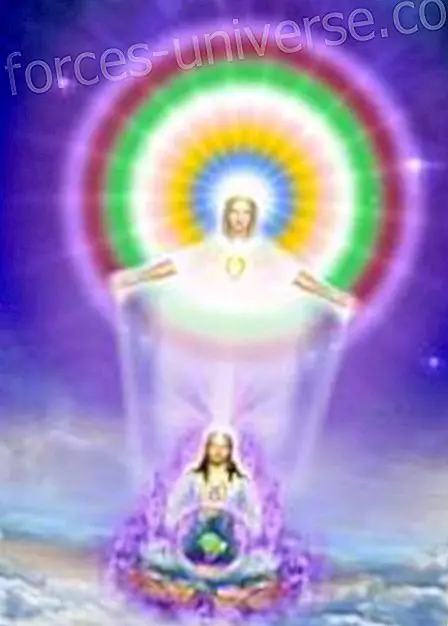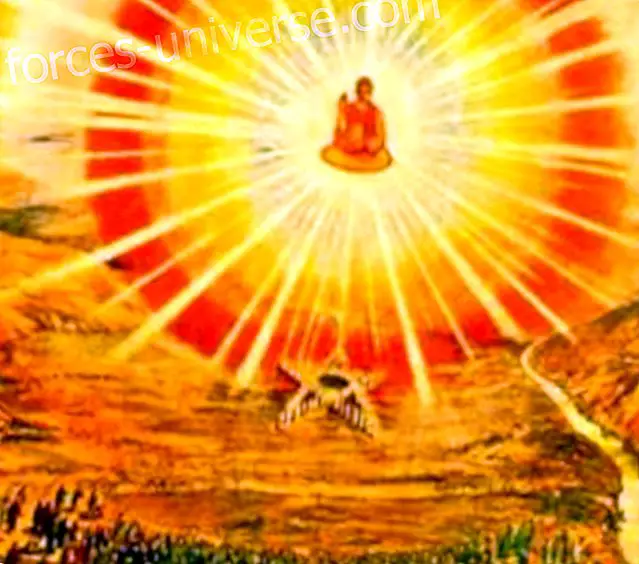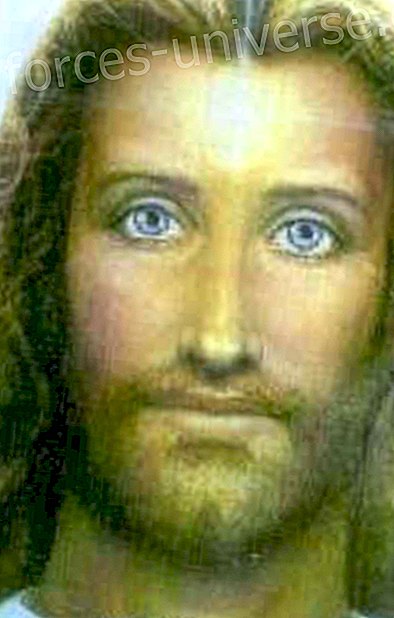 The problem of the liberation of the human soul and its individual relationship with immanent God and transcendent God, is the spiritual problem that worries all world religions today. There is a Transcendent God who "having merged the entire universe with a fragment of Himself" can still say: "I remain." There is an Immanent God whose life is the origin of all activity, intelligence, growth and attraction of all forms in all the kingdoms of nature. Similarly, there is in each human being a transcendent soul who, when he has begun and finished his life cycle on earth and the period of manifestation has passed, becomes again unmanifested and amorphous, and can also say: “I I remain. " When it manifests and takes shape, the only way in which the human mind and brain can express their recognition of the conditioning divine life is to speak in terms of Person and Individuality. That is why God is spoken of as a Person, of His will, of His nature and His form.
The problem of the liberation of the human soul and its individual relationship with immanent God and transcendent God, is the spiritual problem that worries all world religions today. There is a Transcendent God who "having merged the entire universe with a fragment of Himself" can still say: "I remain." There is an Immanent God whose life is the origin of all activity, intelligence, growth and attraction of all forms in all the kingdoms of nature. Similarly, there is in each human being a transcendent soul who, when he has begun and finished his life cycle on earth and the period of manifestation has passed, becomes again unmanifested and amorphous, and can also say: “I I remain. " When it manifests and takes shape, the only way in which the human mind and brain can express their recognition of the conditioning divine life is to speak in terms of Person and Individuality. That is why God is spoken of as a Person, of His will, of His nature and His form.
The East supports the concept of the Buddha of transcendent Deity, separated from the triplicity, duality and multiplicity of manifestation. In the Western religiosity that Christ has formulated and preserved , the concept of immanent God persists - God in us and in all forms. In the synthesis of the teachings of the East and the West and in the fusion of these two great schools of thought, something of this superlative All, merely present, but not known, can be presented. These two great Sons of God have established two main energy stations and two power stations, and have greatly facilitated the descent of divine life to manifestation. The Way is already open, so that the rise of the sons of men is possible. Around the two ideas of divine descent and the corresponding human ascent, the new religion must be erected. The tonic of the New World Religion is the Divine Approach. "Approach Him and He will approach you" is the mandate that emerges from the Hierarchy, in new and clear accents. The great theme of the New World Religion will be the unification of the great Divine Approaches; the task of the churches is to prepare humanity, through organized spiritual movements, for the fifth and imminent Approach; The method to be implemented will be the scientific and intelligent use of Invocation and Evocation, plus the recognition of its wonderful power; The objective of the coming Approach, of preparatory work and of invocation, is revelation - revelation that has always been cyclically given and that is now in a position to be accepted by human beings.
 Divinity: immanence and transcendence.
Divinity: immanence and transcendence.
While Deity is the origin of everything that is divine. Divinity is the characteristic, unifying and coordinating quality of Deity. Deity is characterized by the quality of unity - actual or potential - at all supermaterial levels of reality, and creatures better understand this unifying quality with the appellation of divinity. DEITY can be personalized as God and for mortals they experience an irresistible impulse to symbolize their finite concepts of God.
Divinity is understandable to creatures as truth, beauty and goodness; it is correlated in personality levels such as love, mercy and ministry; and it is revealed on the impersonal levels as justice, power and sovereignty. The conscience of the moral duty that the human being has, and his spiritual idealism, represent a level of values an experiential reality that is difficult to symbolize.
The universe of universes manifests the phenomena of deity's activities at the various levels of cosmic realities, mental meanings and spiritual values, but all these ministries are divinely coordinated. Religiosity transforms qualities into values.
 Religion: mysticism and mentalism.
Religion: mysticism and mentalism.
The thinking of men has always been religious. There has been no time when religion and the thoughts of men about God, the Infinite and Life that brought everything into existence were not present. Even the most ignorant wild races have recognized a Power and tried to define their relationship with that Power, in terms of fear, sacrifice or propitiation. From the rudimentary adoration of nature, fetishism and degraded adoration of the idols, of primitive man, we have erected a structure of truth, which although it is still imperfect and inadequate, in In effect, lay the foundations of the future Temple of Truth, where the light of the Lord will be seen and will be an adequate expression of Reality.
Between the stages of lower-level psychic life and the spiritual perception of the initiate there are all possible types of conscious perception, which can be divided into three main categories:
1. The development and use of psychic powers. The stage of the Schism.
2. The evolution of the vision. The stage of mysticism.
3. The revelation of light and power. The stage of Mentalism.
The psychism is the set of faculties, abilities and powers of the One Soul.
Mysticism is the technique to cultivate the awareness of the presence of God, and it can become a technique to evade reality. The characteristic of the mystical state is the diffusion of consciousness with vivid islands of focal attention that operate on a comparatively passive intellect. All this brings awareness to the subconscious rather than leading it in the direction of the spiritual contact zone, the superconscious.
Mentalism is the science of the manipulation of energy, the attraction aspect or repulsion of force. The word energy is used to express the living activity of the spiritual realms and of that spiritual entity that is the soul. The word force is used to express the activity of the nature of the form in the domains of the various kingdoms of nature.
The keynotes that mystics have recognized and that religious thinkers and writers are inclined to admit, are the feeling and sensitivity to divine existence, and the recognition of a vision of God, sufficient to meet individual needs and provide relief, peace, understanding and perception of internal and external divinity, and in addition to the relationship between man and some foreign factor called God, I, or the Christ.
The key notes of mentalistic life have been, as appropriate, knowledge, the mental approach to the problem of divinity, the recognition of divine immanence and the fact that "as He is, so are we." However, there is no sense of duality there. The goal is to achieve an approved and determined identification that turns man into what he is - a God and, in time, God in manifestation.
Esotericism, sponsored by modern groups and the most mental types, considers all events, world movements and national governments, and also all political facts, as expressions of the energies found in the inner world of esoteric research. . Esotericism arose from those limits of science where matter and energy could no longer be penetrated, dedicating the exoteric to the outside and the esoteric to the interior but nowadays technology is ahead of science, which has facilitated delve into the sea of knowledge and rise to the clouds of cognizable things, which was giving rise to the philosophy of the mind. Today mentalism is presented as the upper level of quantum mysticism and the lower level of occultism.
One could now indicate that aspiration and mystical development are the way to avoid the higher aspects of the Atlantean consciousness. In itself it is astral in nature. Science and the occult are the way to avoid the superior expression of the concrete mind and the Arian consciousness of a mental nature.
Philosophy has been dedicated to interpreting mental meanings and it remains for religion to reveal spiritual values. The religiosity of the future will be based on the science of Invocation and evocation.
 Sources of Religion
Sources of Religion
Every great religion that arises is under the influence of one of the rays, but it does not necessarily mean that each successive ray will result in a powerful religion. It is said that brahamanism is the last great religion that arose under the influence of the first ray; it is unknown what the religion resulting from the last period of the second ray might have been, but the religions of Chaldea, Egypt and Zoroaster can be said to represent the third, fourth and fifth rays respectively. Christianity and probably Buddhism were the result of the influence of the sixth ray. Mohammedanism, which has a very large number of adherents, is influenced by the sixth ray, but it is not a great root religion, but a hybrid offshoot of Christianity, with a Jewish hue.
Melchizedek taught the concept of one God, a universal Deity, but allowed the people to associate their teachings with the Father of the Constellation, whom he called The Elyon - the Most High. Melchizedek remained practically silent about Lucifer's situation. For most Salem students, Edentia was heaven and the Most High was God. The symbol of the three concentric circles, which Melchizedek adopted as the insignia of his bestowal, was interpreted by a majority of the people as a symbol of the three kingdoms of men, angels and God. They were allowed to persevere in that belief; Very few of his followers ever knew that these three circles were the emblem of the infinity, eternity and universality of the Paradise Trinity of divine maintenance and direction.
Where the residue of the teachings of the Melchizedek disciples was best preserved was in the doctrines of the cynics, with the exception of those that survived in the Jewish religion.
“ God is supreme; He is the Most High of heaven and earth. God is the perfected circle of eternity, and governs the universe of universes. He is the only maker of the heavens and the earth. When he decrees one thing, that thing is. Our God is a unique God, and is compassionate and merciful. Everything that is elevated, holy, true and beautiful is similar to our God. The Most High is the light of heaven and earth; He is the God of the east, of the west, of the north and of the south ... ”
The skulls of Palestine saved many teachings of Melchizedek, and those archives, as they were preserved and modified by the Jews.
“In the beginning, God created the heavens and the earth and all the things they contain. And behold, everything he created was very good. It is the Lord who is God; there is no one but him, neither above in heaven nor below on earth. That is why you will love the Lord your God with all your heart, with all your soul and with all your strength… ”
Buddhism was close to being a great and beautiful religion, but without God, without a personal and universal Deity. However, some writing of certain previous beliefs was found that reflected a little the influence of the teachings of the Melchizedek missionaries, who continued their work in India even until the time of Buddha.
“Joy will flow from a pure heart towards the Infinite; My whole being will be at peace with this supermortal rejoicing. My soul is full of satisfaction, and my heart overflows with the joy of a gentle confidence. I have no fear; I'm free of anxiety ... "
The missionaries of Melchizedek took the teachings of the one God to all the places where they passed. A large part of this monotheistic doctrine, together with other previous concepts, was incorporated into later teachings of Hinduism.
“He is the great God, supreme in every way. He is the Lord who encompasses all things. He is the Creator and controller of the universe of universes. God is a unique God; he is alone and exists by himself; he is the only one. This unique God is our Maker and the ultimate destiny of the soul. The Supreme shines in an indescribable way; It is the Light of the Lights. This divine light illuminates all hearts and all worlds ... "
Zoroaster was personally in direct contact with the descendants of the first missionaries of Melchizedek, and the doctrine of the one God became the central teaching of the religion he founded in Persia. Apart from Judaism, no religion of this era contained more of these Salem teachings.
“All things come from the One God and belong to him — he is infinitely wise, good, just, holy, resplendent and glorious. This, our God, is the origin of all luminosity. He is the Creator, the God of all good intentions and the protector of the justice of the universe ... "
The third group of religious believers who preserved the doctrine of a unique God in India was known at that time as the Suduanists. These believers are more recently known as the followers of Jainism. Here is what they taught:
“The Lord of Heaven is supreme. Those who commit sin will not ascend to heights, but those who walk the path of righteousness will find a place in heaven. We are sure of life in the future state if we know the truth… ”
The manuscripts of Shintoism, a religion of the Far East, had recently been placed in the library of Alexandria. This belief also contained remnants of Melchizedek's first teachings, as evidenced by the following excerpts:
“The Lord says: 'You are all recipients of my divine power; All men benefit from my ministry of mercy. I am very pleased with the multiplication of the righteous by all nations. Both in the beauties of nature and in the virtue of men, the Prince of Heaven tries to reveal himself and show the rectitude of his nature ... "
Melchizedek's religiosity penetrated deep into China, and the doctrine of the one God was part of the first teachings of various Chinese religions; Taoism was the one that lasted the longest and contained the greatest amount of monotheistic truth.
“How pure and serene is the Supreme, and yet how powerful and strong, how deep and unfathomable! This God of heaven is the venerated ancestor of all things. If you know the Eternal, you are enlightened and you are wise. If you do not know the Eternal, that ignorance manifests itself as evil, and thus the passions of sin arise… ”
 Spiritual leaders.
Spiritual leaders.
From the darkness of time the great religions have emerged, which, although diverse in their theologies and forms of worship, although they are characterized by different types of organization and ceremonial and differing in their Methods of applying truth are united in three fundamental aspects:
1. In his teaching, regarding the nature of God and man.
2. In its symbolism.
3. In certain fundamental doctrines.
When men recognize this and manage to isolate that internal and meaningful structure of the truth, which is the same in all climates and in all races, then universal religion, the One Church and that unified one will emerge, although not uniform approach to God, who will demonstrate the truth of the words of St. Paul A Lord, a faith, a baptism; God and Father of all, who is above all and by all and in all. Theologies will disappear upon knowing God; doctrines and dogmas will no longer be considered necessary, because faith will be based on experience, and authority will give way to a personal appreciation of Reality. The power of the Church over the group will be replaced by the power of the soul, awakens already in men; the time of miracles and disputes over why and how these miracles, with the consequent skepticism or agnosticism, will yield to the understanding of the laws of nature that they control the superhuman kingdom and the supernatural stage of the evolutionary process. Man will receive his divine inheritance and will recognize himself as the Son of the Father, with all the divine characteristics, powers and abilities that belong to him by divine endowment.
There have been hundreds and hundreds of religious leaders in a million years of human history on Urantia, from Onagar to guru Nanac. During this time there have been many ebbs and flows of the tide of religious truth and spiritual faith, and every rebirth of the Uranian religion in the past has been identified with the life and teachings of one or the other. der religious. When considering the masters of recent times, it may be useful to group them into seven major religious ages of the Planet after Adam:
1.The setite period. The Sethite priests, as they regenerated under the leadership of Amosad, became the great masters. They functioned throughout the Andite lands, and their influence persisted longer among the Greeks, Sumerians and Hindus. Among the latter they continued to the present as brahmins of the Hindu faith. The Sethites and their followers never completely lost the concept of the Trinity revealed by Adam.
2. It was from the Melchizedek missionaries. The Urantia religion was regenerated considerably by the efforts of those teachers who were commissioned by Machiventa Melchizedek who lived and taught in Salem almost two thousand years a. of JC These missionaries proclaimed faith as the price of God's favor, and their teachings, although they did not produce religions that appeared immediately, nevertheless formed the foundations upon which the Urantia religions would build the most Recent teachers of truth.
3. The era after Melchizedek. Although Amenemope and Ikhnaton both taught in this period, the outstanding religious genius of the post-Melchizedek era was the leader of a group of Levantine Bedouins and founder of the Hebrew religion: Moses s. Moses taught monotheism. He said: "Hey, Israel, the Lord our God, the Lord is one." “The Lord he is God. There is no other outside it. ” He persistently tried to uproot the vestiges of the ghost cult of his people, even prescribing the death penalty for his practitioners.
The monotheism of Moses was adulterated by his successors, but in more recent times they returned to many of his teachings. The greatness of Moses lies in his wisdom and sagacity. Other men have had greater concepts of God, but no man ever managed to induce so many people to adopt such advanced beliefs.
4.The sixth century before Christ. Many men emerged to proclaim the truth in it, one of the greatest centuries of religious awakening ever witnessed on Urantia. Among these we can mention Gautama, Confucius, Lao-tse, Zoroaster and the Jain teachers. Gautama's teachings have spread widely in Asia, and he is revered as Buddha by millions. Confucius was for Chinese morality what Plato was for Greek philosophy, and although there were religious repercussions of the teachings of both, in strict terms, neither was a religious teacher; Lao-tse visualized God more in Tao than what Confucius did in humanity or Plato in idealism. Zoroaster, although greatly affected by the dominant concept of dual spiritism, good spirits and evil spirits, at the same time clearly exalted the idea of an eternal Deity and the final victory of light over darkness.
5.The first century after Christ. As a religious teacher, Jesus of Nazareth began with the cult that John the Baptist had established and progressed as far as he could from fasting and forms. Apart from Jesus, Paul of Tarsus and Philo of Alexandria were the greatest teachers of that era. His religious concepts have played a dominant role in the evolution of that faith that bears the name of Christ.
6. The sixth century after Christ. Muhammad founded a religion that was superior to many of the creeds of that time. His was a protest against the social demands of the faith of foreigners and against the inconsistency of the religious life of his own people.
7. The fifteenth century after Christ. This period witnessed two religious movements: the disorganization of the unity of Christianity in the west and the synthesis of a new religion in the east. In Europe, institutionalized Christianity had reached such a degree of lack of elasticity that any further growth was incompatible with unity. In the east the combined teachings of Islam, Hinduism and Buddhism were synthesized by Nanac and his followers in Sikism, one of the most advanced religions in Asia.
Since the revelation of the Ascended Masters, the religious truth of the paternity of God and the fraternity of all creatures has spread. But it is to be hoped that the ardent and sincere efforts of these prophets are directed less towards strengthening interreligious barriers and more towards increasing the religious fraternity of spiritual worship among the many followers of different intellectual theologies.
 Revelation and Initiation:
Revelation and Initiation:
Through revelation processes, divinity is slowly emerging in human consciousness. The revelation is sevenfold; each of the seven kingdoms of nature reveals an aspect of it, and each of them obtains revelation through seven or fourteen revelations or minor phases. It is important to learn to distinguish between the vision (which constitutes a divine revelation, as far as the disciple can grasp it in time and space) and revelation, synthesis of the expressive divine purpose, which is related to the will to good, and in turn constitutes the Total expression of the love nature of Deity.
There have been many events of religious revelation but only five of epochal significance. These were as follows:
1. The Dalmatian teachings . The true concept of the First Source and Center was promulgated for the first time on the planet by the hundred corporeal members of the entourage of the planetary Prince.
2. The Edenic teachings. Adam and Eve again illustrated the concept of the Father of all for evolutionary peoples.
3. Melchizedek of Salem . This Son of urgency of the Local Universe inaugurated the third revelation of the truth on the planet. The cardinal precepts of his teachings were trust and faith.
4. Jesus of Nazareth. Christ presented for the fourth time to the planet the concept of God as Universal Father, and this teaching in general has persisted since then. The essence of their teaching was love and service, the service of free will that the Masters grant to their brothers in the joyful understanding that, through this service, they are serving God the Father in the same way.
5. The Urantia Book. It constituted the first channeling (1934) of the truth of God to the mortals of the planet. It differs from all previous revelations, because it was the combined work of many beings.
The teaching programmed by the Hierarchy to precede and condition the new era of Aquarius, was of three categories:
1. High school, given between 1875-1890 written by Helena Petrovna Blatvasky.
2. Intermediate, given between 1919-1949 written by Alice A. Bailey.
3. Revealing, it emerged after 1975 given on a large scale by the media.
At the beginning of the 21st century, this teaching continued, given in a series of treaties, linkers of the materialistic knowledge of man and the science of the initiated. What remained of the previous century, should have been dedicated to the rebuilding of the sanctuary in which man lived, to the reconstruction of the way humanity lived, to the reconstruction of the new civilization on the foundations of the old one, and to the reorganization of the structures of world thought and politics, plus the redistribution of the world's resources according to the divine purpose. Only then was it possible to expand the revelation. The religiosity of divine acknowledgments.
The new truths that El Tibetano took responsibility for as a transmitting agent, before the world, of occult students, were:
- The Teaching regarding Shamballa .
- The Teaching on the New Discipleship.
- The Teaching regarding the Seven Rays .
- Teaching about the new Astrology.
- Information about the New Group of World Servers.
- The attempt to form an exoteric branch of the internal ashramas.
- Teaching about the new world religion .
Spirituality:
Spiritual is what relates man to man, and this one to God, and that manifests itself as a better world and as an expression of the Four Freedoms on the planet. For them the spiritual man must work. Spirituality is, essentially, the establishment of correct human relationships, the promotion of good will and, finally, the establishment of true peace on earth, as a result of these two expressions of divinity (Love and the will).
A New World Religion is expressed through the work of esoteric groups around the world, due to the particular emphasis placed on the existence of the spiritual Hierarchy, the function and work of the Christ and the technique of meditation, by which You can achieve soul consciousness, or Christ consciousness. The prayer has expanded to become meditation; desire has risen and has become mental aspiration.
The task of the working groups led by the Masters of Wisdom, is to allow the entry of light, using the existing tears in the veils of maya. Three large tears produced in the veils. The Bible refers to them in symbolic form, although their essential meaning has not been observed or understood.
The first was produced by the establishment of the Law of God, which the Old Testament symbolically describes in the episode of Moses, when he ascended to the Mount of God, and there he received the Ten Commandments; expression of the divine law adapted to humanity and necessary to project the forces that destroy, purify and reorganize. Moses, the Encoder, entered one of the classrooms inside the veils of maya and there he found the glory of the Lord.
The second and very important tear was produced by the power of the second aspect, when Christ submitted Master Jesus to the fourth initiation, and his joint influence triumphed over death. We read that the veil of the Temple was torn from top to bottom. The encoder was present when the first tear occurred, as the culmination of the third initiation, a similar process of glorification taking place. An analogous event occurred in the Transfiguration of Christ, exerting influence or, rather, acting through the Master Jesus.
Another tear of the veil, relatively minor, took place when Saul of Tarsus contemplated the glory of the Lord and became Paul, the Apostle. As he struggled to reach the light he wrote the Epistle to the Hebrews that has sparked so much controversy. In it the results of the tearing of the third veil provide the keynote and express the first and highest aspect, just as the first two tears led to the revelation of the third and second divine qualities. The first aspect can be considered a synthesis, the Communion of Saints, and related to the Lord of the World, Melkisedek.
The Law, Love, the Synthesis Union, the great energies that have infiltrated human consciousness, provide today the structure upon which the new civilization will be founded, is it will originate a new approach to God and new human relationships will develop.
The platform of the new world religion will contain, in the same way, three main presentations of the truth, or three doctrines. The elaboration of these three points of view or evocations of the truth, will be the work of the group of idealistic disciples:
The reality of the Spirit of God will be demonstrated, both transcendent and immanent, and also a similar reality in relation to man. The method of mutual approach through the soul will be indicated. This aspect of emerging truth could be called Transcendental Mysticism.
The reality of the divine quality possessed by the forces of nature and of man and the method by which man uses them for divine purposes. This could be called Transcendental Mentalism.
The reality, implied in the first point, that humanity as a whole, is an expression of divinity, a total expression, plus the affinity of nature and of the divine work of the Planet Hierarchy, and the method of reciprocal approach of both groups, in group form. This could be called Transcendental Religion.
The Father, the Son and the Holy Spirit of Christian theology, personifying, as they do, the triplicities of all theologies, also become the One when they have The manifestation period is over. They remain as One, with the quality and life intact and undifferentiated, as they are in manifestation.
The analogy of this is when a man dies. Desaparecen sus tres aspectos -mente o voluntad, emoci no amor, y apariencia f sica. Entonces la persona no existe. Sin embargo, si se acepta el hecho de la inmortalidad, el ser consciente perma nece; su cualidad, prop sito y vida est n unidos con su alma inmortal. La forma externa, con sus diferenciaciones en una tri nidad manifestada, ha desaparecido -nunca volver exactamente en la misma forma o expresi n, en tiempo y espacio.
EDITOR'S NOTES.
El libro de Urantia fue una fuente valiosa para este art culo

 Divinity: immanence and transcendence.
Divinity: immanence and transcendence.  Religion: mysticism and mentalism.
Religion: mysticism and mentalism.  Sources of Religion
Sources of Religion  Spiritual leaders.
Spiritual leaders.  Revelation and Initiation:
Revelation and Initiation: 




